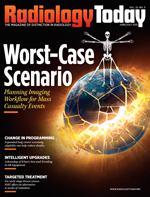 Imaging Informatics: Super Models
Imaging Informatics: Super Models
By Dave Yeager
Radiology Today
Vol. 22 No. 5 P. 28
Three-dimensional models based on medical scans are valuable planning and educational tools. And, as 3D models become more sophisticated, physicians, surgeons, and educators are finding additional ways to use them. Now, a team from The Ottawa Hospital and the University of Ottawa in Canada is working to advance the field further.
The team has created Elucis, a platform that allows users to create and view 3D models in virtual reality (VR). Users can choose to create physical models or simply view them in the platform. Elucis was born from experiments that the team carried out in an attempt to answer a burning question: “How does Superman actually do X-ray vision?” asks Justin Sutherland, PhD, MCCPM, an assistant professor in the department of radiology and the faculty of medicine at the University of Ottawa. “This new era of virtual reality technology allows us to interact with 3D medical images in new ways. So there was this notion we had in our heads that we can recreate the types of things you would imagine this superpower to be.”
Most people are familiar with Superman’s ability to see organs in people’s bodies, but the researchers were interested in the physics behind it. Specifically, how is he able to see, for example, the surface of someone’s heart vs something else? The research team sought to re-create that ability within their platform.
They found VR to be particularly useful for creating 3D content from medical images and engaging with them. Rather than starting with a medical image and performing laborious segmentations to turn it into a digital model, a virtual environment streamlines the process. Users are able to import images and view 3D content as it’s being generated, allowing them to immediately begin using the VR models in the same ways as 3D-printed models. Sutherland says the process is much more intuitive than traditional 3D modeling.
“That really led to its value proposition,” Sutherland says, “to an augmentation and, in some cases, a replacement for 3D printing.”
Enabling Technology
To commercialize the platform, the research team created a company, Realize Medical, and licensed the technology from The Ottawa Hospital. Research is ongoing at The Ottawa Hospital, and the research team is partnering separately with the University RWTH Aachen in Germany. Because the platform is currently a research-only tool, it does not require FDA clearance. However, the company is pursuing 510(k) clearance and hopes to obtain approval by the end of 2021.
The VR models are already finding their way into practice. One Elucis user is a pediatric cardiologist who is using the platform to create and import models that she can manipulate. She is using them for remote collaboration with colleagues. The cardiologist and her colleague are able to discuss the model in the platform at the same time, while wearing headsets.
Other users are using the platform for education. A biology professor at the University of Utah is using it to teach a course on animal anatomy. The school’s library purchased computers and headsets that allow students to take part in lectures and view scans of whatever animal is being studied. The professor is also able to create assignments that are completed in the platform.
Sutherland sees the platform as an enabling technology. Users can print 3D models with one click or edit the models in VR in real time. The platform also fits into established workflows. If users have a preferred way of generating 3D content, they can import the models into the platform.
The research group’s current focus is preprocedure planning. Sutherland believes there’s significant space to innovate in that area. He notes that VR’s role in medicine is still largely unknown, and he expects that many new applications will be developed in the future.
“It’s more like an architect than someone who’s practicing building a house,” Sutherland says. “One of the things we see that people tend to discount with virtual reality is that it’s not just the technology that lets you simulate the real world, but it's one that lets you generate entire new worlds of your choosing.”
To enhance the platform, Realize Medical is adding AI tools that will be released later this year. The tools leverage human-manual input in ways that aren’t possible on 2D platforms. Sutherland says many of the platform’s algorithms are semiautomatic, rather than fully automated, but they perform as well as or better than fully automated processes because of user input.
The AI algorithms are designed to further improve that process. The platform allows users to quickly visualize and edit their work, and the algorithms help speed up the process. They also provide live feedback to users so they can easily identify and fix problems.
“In the 3D modeling space, deep learning already does and will continue to play a huge role,” Sutherland says. “We really see it as putting your name at the top of the test. It’s not bonus marks; it’s just something that everyone’s going to have. But we’re really excited about the things that we’re releasing later this year that have to do with how you can interact with the result that the 3D algorithm gives you.”
— Dave Yeager is the editor of Radiology Today.

